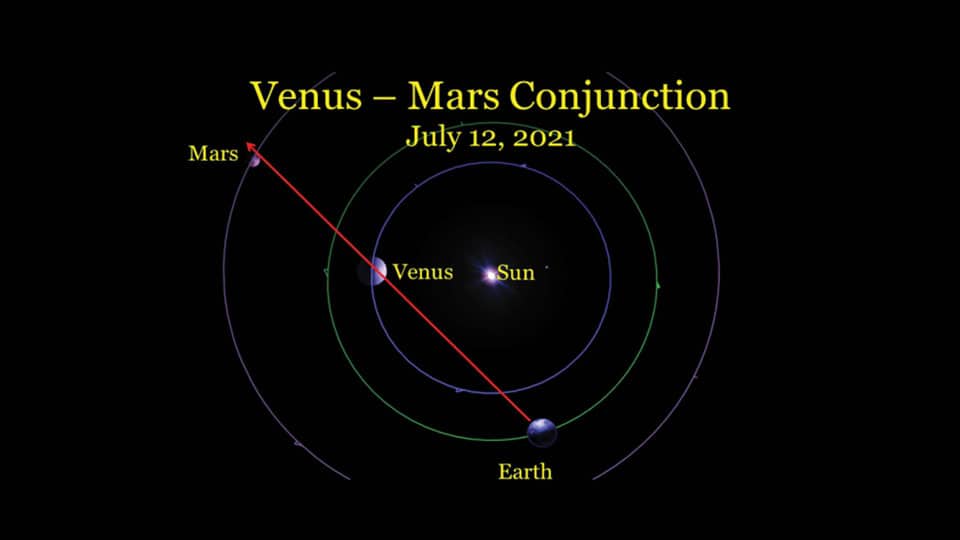By Dr. S.A. Mohan Krishna, Amateur Astronomer
In a celestial event termed ‘planetary conjunction,’ Mars and Venus are expected to be 0.5 degrees apart as observed from Earth, though they are truly further apart. Many astronomy and space-related organisations, observatories, planetariums, observational astronomers and astronomy connoisseurs/ aficionados have stated that the conjunction will also include the Earth’s Moon coming close to
within four degrees of the planets. The three-celestial-body conjunction can be observed in the sky from July 8 till July 13 for anyone who wants to catch the apparent coming closer of Mars and Venus. They are expected to move away progressively after July 13.
The year 2021 has been very favourable for planets to line up gracefully and exhibit their exquisiteness and sumptuousness. Venus, Mars, Jupiter and Saturn have been dominating since 2020 and have experienced closer encounter with planet Earth.
Skywatchers are in for an astronomical extravagance as two of Earth’s neighbouring planets, Mars and Venus, are expected to come closest to each other in the sky on July 12-13. The moon will also pass closest to the two planets on July 12. This will be perceptible to the naked eye and can be witnessed in the western horizon under clear weather conditions just after Sunset.
The most celebrated planets, Jupiter and Saturn, were closest to each other in the sky on Dec. 21, 2020 appeared only a tenth of a degree apart. They remained in close alignment for a few days and were effortlessly evident to the naked eye when looking toward the southwest just after Sunset. Great conjunction of 2020 marked the first time in nearly 800 years since the planets aligned at night and astronomy enthusiasts were able to witness this rare celestial spectacle.
The planetary orbits of Saturn and Jupiter brought these planets into alignment once every 20 years or so, 2020 marked the first time since 1623 that the two gas giants have passed this close to one another. The conjunction on July 16, 1623 was not conspicuous to skywatchers on much of the Earth because of its location in the night sky, so the last time the event was discernible was on March 5, 1226. The date of the planetary conjunction was determined by the stipulated positions of the gas giants — Jupiter, Saturn and the Earth in their trajectory around the Sun, while the date of the solstice is determined by the tilt of Earth.
In a celestial event termed ‘planetary conjunction,’ Mars and Venus are expected to be 0.5 degrees apart as observed from Earth, though they are truly further apart. Many astronomy and space-related organisations, observatories, planetariums, observational astronomers and astronomy connoisseurs/ aficionados have stated that the conjunction will also include the Earth’s Moon coming close to within four degrees of the planets. The three-celestial-body conjunction can be observed in the sky from July 8 till July 13 for anyone who wants to catch the apparent coming closer of Mars and Venus. They are expected to move away progressively after July 13.
The planetary alignment will be observable only from Earth. It can be viewed from anywhere in India in clear skies. Both planets can be spotted aligned in the same frame through telescopes or binoculars. The angles of the paths are set to be slightly different for northern parts of India. In astronomy, a conjunction occurs when any two astronomical objects such as asteroids, moons, planets and stars seem to be close together in the sky, as observed from Earth.
The Moon’s thin crescent will hover near the planetary pair the two previous evenings, offering striking views to astrophotographers with clear western skies. On the evening of 11th July, Venus will lie 5.5° southeast of the ultra-thin crescent Moon (5 percent illuminated), which will set about 90 minutes after the Sun. The planets themselves will appear just 1° apart, a distance that is nearly cut in half the following evening. On 12th July, Venus will stand just over 7° west of the 10-percent-illuminated Moon, which sets coarsely two and a quarter hours after the Sun. It will be its usual dazzling self, shining at apparent magnitude –3.9. Mars, unfortunately, will be quite a bit fainter, glowing at magnitude 1.8. That means Venus will be 190 times brighter than Mars, so we will have to let twilight dwindle some for us to be able to spot the red planet. Both celestial objects lie in the constellation Leo the Lion.
The refulgent planet Venus and red planet Mars remain fixtures of the early evening sky throughout July 2021. Venus will be blazing away in western sky some 40 to 45 minutes (or sooner) after Sunset. Mars won’t pop out in the purlieu of Venus until dusk gives way to nightfall. Mars starts out the month above Venus and ends the month below Venus. Day by day, Venus climbs upward, away from the setting Sun. Day by day, Mars sinks downward, toward the setting Sun. The lunar crescent helps to guide to Venus and Mars at dusk/ nightfall from July 11 to 14. Unpretentiously bright Mars is objectively easy to see in a dark sky. But it might be hard to spot Mars next to Venus from mid-and-far northern latitudes, where these two worlds set before nightfall. The next Venus-Mars conjunction will occur on Feb. 22, 2024. On that date, 38’ will separate the pair, which will lie in Capricornus in the morning sky, 26° west of the Sun. In order to see a pairing between Venus and Mars as close as the one this month, we will have to wait until May 11, 2034. So, do not forget to see to this planetary conjunction on July 12-13.








Recent Comments